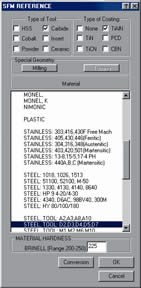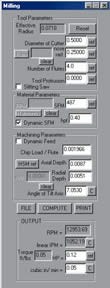Lending A Hand To The Handbook
A software calculator offers speed, feed and depth of cut values that recognize the distinctive characteristics of a high speed cut.
Share



ECi Software Solutions, Inc.
Featured Content
View More




Takumi USA
Featured Content
View More
Autodesk, Inc.
Featured Content
View MoreThe combination of high spindle speed and low depth of cut has a way of leaving many machining data tables behind. Chip thinning, chatter and the possibility of a reduced cutting radius on a ballnose tool are all common phenomena in high speed machining that can render a handbook’s recommended cutting parameters ineffective. Shops that run at high speeds and low depths often have to find their optimum cutting parameters through physical testing on their own shop floors.
But is testing the only way to get these numbers? Cutting parameters that adjust for chip thinning, for a ballnose tool’s effective radius, and even for chatter can all be predicted mathematically, given a model that has enough information. No data table published on a printed page could account for all of this information, but a software utility might.
That’s the thinking behind the High Speed Machining Calculator recently developed by two CAD/CAM programmers working in San Diego, California. After the appropriate information about the tool and the cut has been entered into data fields, the calculator returns recommended milling parameters that take account of the high-speed and low-depth effects. The calculator runs in a small window over the top of the user’s CAM software.
Its developers, Arnel Canja and Terrell Moose, drew on their experience programming dies, aircraft components and other parts for a local Naval air depot. The Navy, in fact, retains free use of the software, but Canja and Moose are free to market it to others. That marketing has proven to be one of the pair's challenges (an early distributor filed for bankruptcy). The calculator is now available through Compu-fast Software.
HSM Effects
“Chip thinning” is one of the effects that this software addresses. Machining data table recommendations for the chip load in milling tend to assume full engagement of the tool, meaning that every tooth is cutting through 180 degrees of rotation. For an end mill taking a finish cut at a low radial depth, the tool engagement stands to be significantly less than that. The High Speed Machining Calculator accounts for this by increasing the feed rate when the radial depth is low in order to keep the chip load productive. For ballnose tools, both the radial and axial depths are considered.
A comparable exercise in trigonometry is used to adjust for a ballnose tool’s effective radius. With this type of tool, the cutting radius is not necessarily the same as the tool radius. Any axial depth of cut smaller than the radius of the ball will not use all of the ball’s diameter, thereby reducing the effective radius of cutting. The calculator not only increases the rpm value during shallow cuts to maintain the target value for sfm, but it also raises the sfm value in those cases where the standard handbook parameters would permit a higher surface speed for a tool with a smaller diameter.
For chatter, the calculator’s approach is necessarily less exacting than this. A true calculation of low-chatter spindle speeds would require frequency-response analysis of the spindle. The calculator is not equipped for this. Instead it relies on the user’s own characterization of the chatter, combined with an analysis that is based on the theory of harmonic overtones drawn from the field of acoustics.
The user describes the chatter as severe, medium or light. The user then chooses between two overtone models that might characterize the chatter behavior. The calculator at this point already has available to it the machining parameters including the rpm value at which this chatter occurred. Based on these inputs, the software returns suggestions for specific low-chatter spindle speeds.
This particular feature of the software has no assurances. Its effectiveness at dealing with chatter can’t be known until a lot more shops have put it to use. However, it does hold out an attractive promise—the chance to master chatter in high speed machining without the technology or the training necessary to measure low-chatter speeds at the machine tool.
Read Next
Registration Now Open for the Precision Machining Technology Show (PMTS) 2025
The precision machining industry’s premier event returns to Cleveland, OH, April 1-3.
Read MoreBuilding Out a Foundation for Student Machinists
Autodesk and Haas have teamed up to produce an introductory course for students that covers the basics of CAD, CAM and CNC while providing them with a portfolio part.
Read More5 Rules of Thumb for Buying CNC Machine Tools
Use these tips to carefully plan your machine tool purchases and to avoid regretting your decision later.
Read More














































